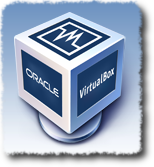Disponibile VirtualBox 3.2.0 Beta 1 (Oracle VM VirtualBox)
 E’ stata rilasciata la nuova release di VirtualBox 3.2.0 in Beta1: chiaramente non è una versione da utilizzare in produzione ma per chi vuol testare le novità può eseguire una nuova installazione su Linux, Windows e Mac OS X.
E’ stata rilasciata la nuova release di VirtualBox 3.2.0 in Beta1: chiaramente non è una versione da utilizzare in produzione ma per chi vuol testare le novità può eseguire una nuova installazione su Linux, Windows e Mac OS X.
Vediamo insieme cosa c’è di nuovo:
- Following the acquisition of Sun Microsystems by Oracle Corporation, the product is now called Oracle VM VirtualBox and all references were changed without impacting compatibility.
- Experimental support for Mac OS X guests
- Memory ballooning to dynamically in- or decrease the amount of RAM used by a VM (64-bit hosts only) (see the manual for more information)
- CPU hot-plugging for Linux (hot-add and hot-remove) and certain Windows guests (hot-add only) (see the manual for more information)
- New Hypervisor features: with both VT-x/AMD-V on 64-bit hosts, using large pages can improve performance (see the manual for more information); also, on VT-x, unrestricted guest execution is now supported (if nested paging is enabled with VT-x, real mode and protected mode without paging code runs faster, which mainly speeds up guest OS booting)
- Support for deleting snapshots while the VM is running
- Support for multi-monitor guest setups in the GUI (see the manual for more information)
- USB tablet/keyboard emulation for improved user experience if no Guest Additions are available
- LsiLogic SAS controller emulation
- RDP video acceleration
- NAT engine configuration via API and VBoxManage
- Guest Additions: added support for executing guest applications from the host system
- OVF: enhanced OVF support with custom namespace to preserve settings that are not part of the base OVF standard
Lista dei problemi risolti:
- VMM: fixed crash with the OpenSUSE 11.3 milestone kernel during early boot (software virtualization only)
- VMM: fixed OS/2 guest crash with nested paging enabled
- VMM: fixed Windows 2000 guest crash when configured with a large amount of RAM (bug 5800)
- VMM: fixed massive display performance loss (AMD-V with nested paging only)
- Linux/Solaris guests: PAM module for automatic logons added
- GUI: guess the OS type from the OS name when creating a new VM
- GUI: added VM setting for passing the time in UTC instead of passing the local host time to the guest (bug 1310)
- GUI: fixed seamless mode on secondary monitors (bugs 1322 and 1669)
- GUI: added –seamless and –fullscreen command line switches (bug 4220)
- Settings: be more robust when saving the XML settings files
- Mac OS X: rewrite of the CoreAudio driver and added support for audio input (bug 5869)
- Mac OS X: external VRDP authentication module support (bug 3106)
- Mac OS X: Moved the realtime dock preview settings to the VM settings (no global option anymore). Use the dock menu to configure it.
- Mac OS X: added the VM menu to the dock menu
- 3D support: fixed corrupted surface rendering (bug 5695)
- 3D support: fixed VM crashes when using ARB_IMAGING (bug 6014)
- 3D support: fixed assertion when guest applications uses several windows with single OpenGL context (bug 4598)
- 3D support: added GL_ARB_pixel_buffer_object support
- 3D support: added OpenGL 2.1 support
- 3D support: fixed Final frame of Compiz animation not updated to the screen (Mac OS X only) (bug 4653)
- Added support for virtual high precision event timer (HPET)
- LsiLogic: Fixed detection of hard disks attached to port 0 when using the drivers from LSI
- NAT: fixed ICMP latency (non-Windows hosts only; bug 6427)
- Keyboard/Mouse emulation: fixed handling of simultaneous mouse/keyboard events under certain circumstances (bug 5375)
- Shared folders: fixed issue with copying read-only files (Linux guests only; bug 4890)
- OVF: fixed mapping between two IDE channels in OVF and the one IDE controller in VirtualBox
Ha fatto molto parlare il punto “Experimental support for Mac OS X guests”: avendo seguito alcune discussioni e letto le note di rilascio, questa feature è chiaramente disponibile solamente nella versione per Mac OS X in quanto Snow Leopard non è ufficialmente installabile su Hardware diverso da quello Apple.
Per maggiori informazioni e per il download:
